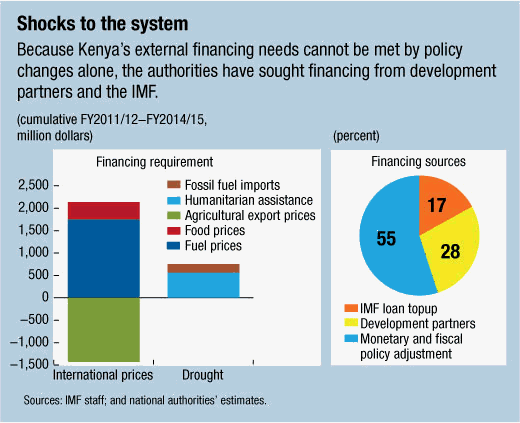ECONOMIC HEALTH CHECK

Typical street scene in Santa Ana, El Salvador. (Photo: iStock)
IMF Survey: IMF Boosts Loan to Kenya to Help Cope With Regional Drought
December 21, 2011
- Kenya hit hard by Horn of Africa drought, faces humanitarian emergency
- Monetary policy to bear brunt of adjustment to rein in domestic demand
- New value-added tax law ready to go to cabinet before end of 2011
The IMF approved Kenya’s request for a loan payout of around $143 million to help the country cope with the severe drought in the Horn of Africa as well as higher food and fuel prices.

Highway project outside Nairobi, Kenya, where investment in road infrastructure is priority to remove bottlenecks to growth (photo: Thomas Mukoya/Reuters)
In its regular review of the country’s economy, the IMF said Kenya was pushing through with an ambitious structural reform agenda while preserving the basis for strong growth.
The new release of loan money is part of a total release to Kenya of around $312 million under its three-year Extended Credit Facility arrangement with the IMF. The IMF’s Executive Board also raised Kenya’s loan ceiling under the arrangement to around $760 million if needed.
IMF First Deputy Managing Director David Lipton noted in a statement after the extra financing was approved December 9 that Kenya’s economy has continued to expand despite the challenges posed by the drought in the Horn of Africa, higher than expected food and fuel prices, and the uncertain global environment. “The authorities are taking decisive measures to address these imbalances and to preserve macroeconomic stability,” Lipton stated.
Drought emergency
Since the beginning of 2011, Kenya has been hit hard by the drought in the Horn of Africa, creating a humanitarian emergency. At the same time, higher international commodity prices and continued strong domestic demand have boosted inflation and swelled the current account deficit, creating additional balance of payments risks.
After a delayed response, the authorities have moved swiftly by adjusting their policies to reduce the pressure on the balance of payments, stem inflationary expectations, and stabilize the exchange rate. Because the external financing requirements cannot be met by policy adjustment alone, the authorities have requested financing from development partners and the IMF (see chart). International development partners have pledged around $450 million to assist Kenya directly in response to the drought.

Inflation, which reached an annual rate of around 19 percent in November 2011, is still above the Central Bank of Kenya’s target range but has run at a much slower pace in recent months. Food and fuel prices have remained higher than anticipated, and exchange rate depreciation has led to higher inflation expectations and faster core inflation.
The central bank has responded by raising its policy rate by a cumulative 11 percentage points since October 2010 in order to reverse inflationary pressures, pushing commercial banks to adjust their lending rates. In addition, rapid fiscal consolidation has helped contain domestic demand.
Curb inflation
The authorities’ economic program plans additional adjustment in monetary and fiscal policies to strengthen the external position while preserving the basis for strong growth. The policies will focus on gradually bringing the growth in domestic demand in line with that of available resources, in order to curb inflation and lower the external current account deficit.
Monetary policy will bear the brunt of the adjustment to rein in domestic demand. The central bank has raised its policy rate substantially and will seek to keep a tight stance to bring inflation down to 7 percent, which is the upper bound of its inflation target range, by end-2012, helped by a reduction in international food and fuel prices.
Fiscal policy will continue to focus on medium-term consolidation, and will front load the adjustment to temper domestic demand. However, priority social spending programs as well as public investment in critical infrastructure projects will be safeguarded. In particular, investment in geothermal and energy projects as well as rail and road infrastructure will continue to be priority in order to remove bottlenecks to growth.
Policy adjustment will be complemented by the additional financing from international development partners and increased access to IMF loans under the Extended Credit Facility arrangement to help rebuild the international reserves buffer.
Structural reforms
Kenya has pushed through with its ambitious structural reform agenda. A new value-added tax law is ready to be submitted to the cabinet before the end of 2011. In addition, the Public Finance Management Law has been submitted to the Commission for the Implementation of the Constitution. This law defines the responsibilities and the revenue sharing mechanism among different levels of government, consistent with the fiscal decentralization envisaged by the new Constitution.
The government has also made substantial progress in preparing the ground for the implementation of an Integrated Financial Management and Information System. Structural reforms in the financial sector, such as the demutualization of the Nairobi Stock Exchange and raising capital requirements for listed companies, are also progressing.
In addition, the National Social Security Fund is undertaking significant reform. A new framework for social security policy will redefine pension schemes, including by transforming the Fund into a social security pension scheme.







